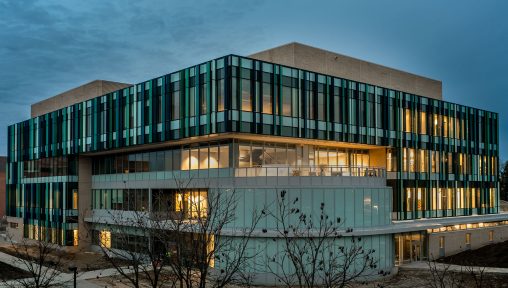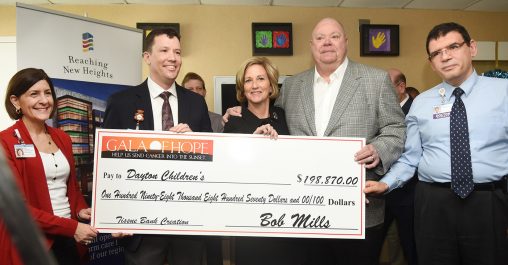 The Gala of Hope Foundation donated $198,870 to Dayton Children’s Hospital, providing for the next step in furthering cancer research in the Dayton region. Bob and Barbara Mills, Gala of Hope Foundation co-founders, presented a giant check to pediatric neurosurgeon Robert Lober, M.D., Ph.D., in the Mills Family Lounge at Dayton Children’s on Dec. 14.
The Gala of Hope Foundation donated $198,870 to Dayton Children’s Hospital, providing for the next step in furthering cancer research in the Dayton region. Bob and Barbara Mills, Gala of Hope Foundation co-founders, presented a giant check to pediatric neurosurgeon Robert Lober, M.D., Ph.D., in the Mills Family Lounge at Dayton Children’s on Dec. 14.
“There is nothing closer to my heart than finding new ways to fight cancer, and ultimately end it, before any child has to go through what my granddaughter did,” said Mills, whose granddaughter, Ally, successfully battled cancer at Dayton Children’s. “I believe the research going on right now, right here in our community could do that.”
Through Dayton Children’s affiliation with the Wright State University & Premier Health Neuroscience Institute, Lober, assistant professor of pediatrics at the Wright State University Boonshoft School of Medicine, is researching brain tumors in children and using high-level imaging to find out what is going on inside them.
This donation will be used to create a research tissue bank, purchase specialized freezers that store, code and organize the tissue samples, and hire a research-level scientist to coordinate the work.
Tumors might appear to be blobs of tissue, but they are actually the body’s own cells turned into renegades, bent on destruction. Just like healthy cells, they have their own metabolism. They need energy to grow, and they also give off energy. Lober wants to better understand that process at the molecular level.

Barbara and Bob Mills, Gala of Hope Foundation co-founders, presented a giant check to pediatric neurosurgeon Robert Lober, second from left, at a ceremony at Dayton Children’s Hospital.
To begin the research, Lober started with test samples he brought with him when he came from Stanford University.
“What we are doing is setting up a tissue study pipeline,” Lober said. “We created an imaging infrastructure to bring data to a cloud-based server for our researchers. We are using the highest level of technology you can find anywhere to study the metabolism of tumors.”
This initiative bridges the gap between pediatric neurosurgeons, pediatric oncologists, physicists, mathematicians, radiologists, pathologists, biochemists and many others within Dayton Children’s and the Neuroscience Institute.
“The amazing thing is we have come further in one year with this collaboration than you could at a larger research institution in many years,” Lober said. “It’s all about being nimble and being able to move quickly. We are demonstrating the capabilities that we have by leveraging our smallness.”
Robert E.W. Fyffe, Ph.D., vice president for research and dean of the Graduate School at Wright State, said the Neuroscience Institute brings strong interdisciplinary teams together to speed the transfer of research discoveries from bench to bedside.
“We know we have some of the best minds right here in Dayton, and they are eager to dive into projects like this,” Fyffe said. “This research will make a difference and change lives.”
Lober works closely with Wright State researchers at the Neuroscience Institute, including Debra Mayes, Ph.D., assistant professor of neuroscience, cell biology and physiology, and Thomas Brown, Ph.D., associate chair for research and professor of neuroscience, cell biology and physiology and professor of obstetrics and gynecology.
Lober is now starting a process allowing other institutions to donate tissue. Each tumor review will add to the pool of knowledge, down to the molecular level, of not only what the tumor cells are, but also how they breathe, eat and reproduce. The use of the 3T MRI at Dayton Children’s, with twice the quality and clarity of most current MRI scanners, helps him in this research.
“This process will be an incredibly powerful tool for cancer research,” Lober said. “You can’t see a gene on an MRI, but you can see how a tumor uses and gives off energy. We are seeing unique patterns of this type of behavior with different tumor types based on their gene expression profiles. Eventually we should be able to reverse engineer this process. One day we might be able to take an MRI of a child’s brain and know, without a biopsy, without any invasive procedures, what kind of cancer it is and how to best defeat it.”
Deborah Feldman, president and CEO of Dayton Children’s, said this type of research could not be done without the generous support of the community.
“This is our third grant from the Gala of Hope Foundation, and we thank Bob and Barbara Mills for continuing to believe in and support our mission to care for each child as if they were our own child,” Feldman said.

 Wright State named a Best for Vets College
Wright State named a Best for Vets College  Wright State’s Boonshoft School of Medicine receives full continuing accreditation from Liaison Committee on Medical Education
Wright State’s Boonshoft School of Medicine receives full continuing accreditation from Liaison Committee on Medical Education  Wright State supports deaf and hard of hearing community with Deaf Festival
Wright State supports deaf and hard of hearing community with Deaf Festival  Wright State students showcase scientific discoveries at annual research festival
Wright State students showcase scientific discoveries at annual research festival  Wright State medical students bring medicine to life for Mini University preschoolers
Wright State medical students bring medicine to life for Mini University preschoolers 